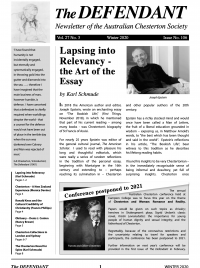The Chesterton novel which has proved singularly popular since it first appeared in 1908 is The Man Who Was Thursday.
It has been the subject of numerous adaptations, particularly for radio, including one in the 1930s by Orson Welles (who was a great admirer of Chesterton) and another by the founder of the Australian Chesterton Society, Tony Evans. A movie adaptation of the novel by the Hungarian writer and director, Balazs Juszt, was made as recently as 2016.
A surprising sign of the book’s enduring popularity has recently emerged. During a visit to Baylor University in Texas, the leading Chesterton scholar, Dale Ahlquist, met the distinguished historian of religion, Philip Jenkins. As Dale notes in the May-June 2020 issue of Gilbert (the magazine he edits on behalf of the Society of Gilbert Keith Chesterton in America), Philip Jenkins revealed a new point of appreciation of The Man Who Was Thursday.
In the 1970s, a British newspaper conducted a poll of both active and retired intelligence operatives – often called “spies” for short – and asked which fictional work best captured the spirit of their profession. The answer that was anticipated would have been a book by a well-known writer of espionage novels, such as Tom Clancy or John le Carré, or even the James Bond novelist, Ian Fleming. But the unexpected response was . . . Chesterton’s The Man Who Was Thursday.
Philip Jenkins told Dale Ahlquist that he has taught criminology, and that this Chesterton novel is a work he keeps returning to.
At the same time, like any classic, The Man Who Was Thursday can be read at various levels of appreciation. In the words of the English novelist, Kingsley Amis, it “is not quite a political bad dream, nor a metaphysical thriller, nor a cosmic joke in the form of a spy novel, but it has something of all three.” (The Amis Collection, Selected Non-Fiction 1954-1990, 1991)
Yet, as Chesterton’s poetic dedication to his life-long friend, E.C. Bentley, makes clear, the book has a profoundly metaphysical meaning – and a decidedly modern relevance. It captures the spirit of elitist cultural loathing with which we are now so familiar, energized by intellectual anarchy and fanaticism.
As Amis points out, quoting passages from a key section of the novel (in chapter IV: “The Tale of a Detective”):
“Chesterton foretold the shape of some of our present discontents. He saw destructive forces in our society that would be nothing but destructive, ‘not trying to alter things but to annihilate them’, basing themselves in the first place on an inner anarchy that denies all moral distinctions ‘on which mere rebels base themselves’.
The Amis Collection, Selected Non-Fiction 1954-1990, The Tale of a Detective
“[As Chesterton wrote] ‘The most dangerous criminal now is the entirely lawless modern philosopher.’ The enemy arises not from the people, but from the educated and well-off, those who unite intellectualism and ignorance and who are helped on their way by ‘a weak worship of intellect and force’ – near the knuckle, that one [as Amis comments].”
The Man Who Was Thursday
Chesterton believed, as one of his characters puts it, “that a purely intellectual conspiracy would soon threaten the very existence of civilization . . . [T]he scientific and artistic worlds are silently bound in a crusade against the Family and the State.”
In Amis’s words:
“By ‘silently’ [Chesterton] can hardly have meant more than ‘secretly’ – if he had meant ‘by an unspoken consensus’ he would have been not just a remarkable prophet but a terrifying one.”
THE AMIS COLLECTION, SELECTED NON-FICTION 1954-1990, THE TALE OF A DETECTIVE
Chesterton – A Chat over Lunch
A Catholic blog site in America, Patheos, recently asked several writers to imagine having lunch with their favourite deceased Catholic writer. Chesterton featured among the most popular authors nominated, and the editor of Patheos, Mark Wilson, published the responses to the question:
If you could have lunch with any deceased writer, who would it be, what would you eat and what would you talk about?
Two writers picked Chesterton. The first, JoAnn Wuland, author of the blog, The Catholic Working Mother, offered this explanation:
